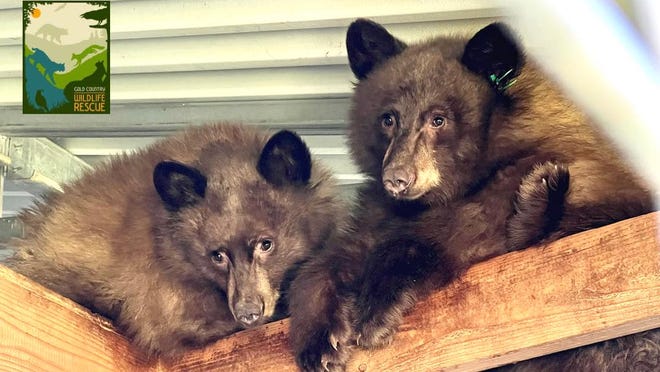Three cubs, a bobcat and a pig rescued from the northern California fires in 2021 have returned home unharmed or will soon be released.
In October, the Redding Record Searchlight published stories about animals that have fallen victim to the state’s raging wildfires, including the 1,500 square mile Dixie Fire.
They and other animals were rescued by wildlife experts and caring neighbors. The injured wild animals received medical attention and then were taken to animal shelters where volunteers fed them and helped maintain their specialized skills and wild ways.
At the end of 2021, we came back with people looking after five of the animals we featured to see how they were doing.
Three little bears still need care
Three orphaned cubs slow down a bit and eat more as the weather cools, said Sallysue Stein, director and volunteer of Gold Country Wildlife Rescue in Auburn. They probably won’t hibernate until next year, after being released into a rugged mountain where temperatures drop well below freezing.
The three bears arrived weighing 16-25 pounds.
- Leo, also known as Smokey Junior, was rescued with burnt paws in the Antelope fire in Siskiyou County on August 11.
- TR was rescued from the Dixie Fire near Taylorsville in Plumas County on August 16.
- Vinnie was also rescued from the Dixie fire on September 5.
“They weigh between 75 and 80 pounds now,” said Stein. “They are typical children. They struggle and play.”
At 11 months, the bears are too young to be released before spring, Stein said. They will spend the winter in a special bear enclosure where they can climb, play and hide in makeshift dens.
Their diet consists of fresh fruits and vegetables and zoo-formula Bear Chow. “Vinnie is a food hog,” Stein said. “The grape is his favorite. “
Rescuers are keeping contact with humans to a minimum to keep bears wild, she said.
Bobcat is back home near Mt Shasta
Lava Bob was not expected to live when he was rescued by Axel Hunnicutt, a biologist with the Siskiyou County Unit of the California Department of Fish and Wildlife in Yreka.
Bobcats were unable to hunt after suffering fourth-degree burns in the lava fire in July.
“He was so skinny. I was surprised I could put a dart at him, ”Hunnicutt said.
But the cat has made a very good recovery, said Stein, recovering quickly from his wounds and going from 15 pounds to 35 pounds of malnutrition – a good weight for a bobcat.
Then he hit 45 pounds, mostly healthy muscle and a fierce catitude.
Capturing him to free him was “quite a challenge,” said Stein. “It took us two to get him into the baby carrier using a catch pole. “
Lava Bob was released in October at the foot of Mount Shasta, eight miles from where he was rescued. If we release animals near where they were found, they usually return home to their home territory, Stein said.
See the video on Lava Bob’s journey from rescue to liberation at https://bit.ly/3zbrVmF.
Pumba the Pig escapes Fawn Fire
In September, the Fawn Fire burned near the Billing family farm near Mountain Gate.
With her husband away, Leighellen Billing had to work quickly with the help of her in-laws to evacuate her three young children, 12 chickens, seven goats, four ducks, two pigs, seven newborn kittens with their mother and three more. cats.
The family’s older pet pig, “Pumba,” took advantage of the situation and fled, she said.
Unable to catch the American guinea pig, Billing had to evacuate without Pumba, believing he would escape the blaze.

When the Billing family returned home eight days later, they saw that he had returned home, uprooted the yard and wallowed in the mud produced by the sprinkler, but Pumba was gone.
After posting his photo on social media, Billing learned that a neighbor had found Pumba. He put the pig – who didn’t look scared or upset at all, Billing said – in his goat pen and gave him treats.
“It was a good 10 minute drive,” she said. Pumba had crossed the freeway, on the Old Oregon Trail.
As the edge of their property burned, Billing’s house was spared from the fire – a blessing Billing credits his goats with for nibbling and clearing a defensible space.
Pumba returned to his enclosure and lived another month before dying of natural causes in October.
“He was a spoiled pig while we had it,” Billing said.
Following:“We learned how resilient nature is”: animals recovering from fire get a little help
How the three bears and the donors reciprocated
Publicity for the rescue and medical treatment of the three cubs helped Gold Country Wildlife Rescue raise $ 250,000 for new habitat designed for future rescued bears.
The ground was inaugurated in November on a 15-acre property in Auburn – the future site of “Bear Cub University,” said Stein.
The new habitat will help keep the bears rescued in the wild, ensuring they don’t get used to humans as they grow or recover from injuries.
“There will be calving and climbing opportunities, so they can practice all the skills they need in the wild,” said Stein.
Construction will begin on the steel enclosure when the weather improves, a “bear-proof” design created by CDFW.
Following:The 3 bear story: Cubs burned in California wildfires recover together
Bear Cub University in Gold Country is one of four bear rescue sites in California. Others are found in Tahoe, Ramona / San Diego, and Sonoma County.
For more information on bears, visit goldcountrywildliferescue.org or https://bit.ly/3ez5JK4 on Facebook.
Jessica Skropanic is a trade journalist for Record Searchlight / USA Today Network. It covers science, the arts, social issues, and entertainment stories. Follow her on twitter @RS_JSkropanic and on Facebook. Join Jessica in Get Out! Neither the Cal recreation Facebook group. To support and perpetuate this work, please register today. Thank you.



